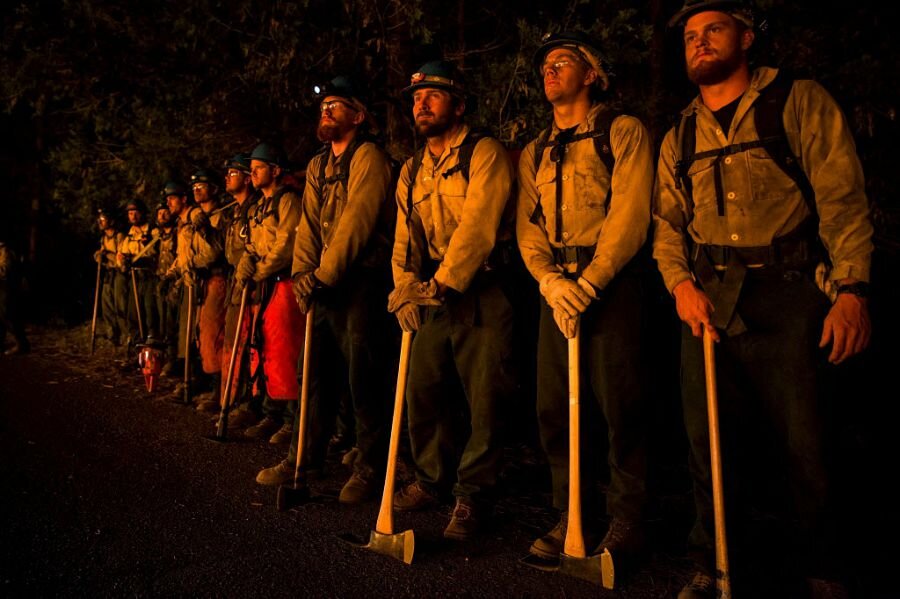Soldiers, prisoners, other countries join massive firefighting effort in the West
Loading...
| Ashland, Ore.
Fighting wildfires across the American West this year has become an unusually massive operation, involving firefighters from around the US and other countries as well as active-duty soldiers and prison inmates, quickly trained and pressed into action.
The area burned so far this year – 7.4 million acres – tops each of the previous ten years. At the moment, according to the National Interagency Fire Center in Boise, Idaho, 70 active, large fires (11 of them new fires) are burning some 1.4 million acres. Hardest hit states are Idaho and California (14 large fires each), Montana (13 large fires) and Oregon and Washington (11 fires each).
Even if fire is not an immediate danger, some areas – including the Rogue Valley here in southern Oregon – are filled with smoke from large upwind fires, pushing air quality into unhealthy categories.
Meanwhile, the dangers associated with wildland firefighting have become tragically evident. So far this year, 13 firefighters have been killed on such fires, four more than all of last year. On Wednesday, three young firefighters were killed battling the Twisp River Fire in north central Washington State.
“He was the light of our life,” Richard Zbyszewski said of his 20-year-old son Tom, who was earning money to attend Whitman College in Walla Walla, Wash. “We’d give anything to have yesterday not happen.”
On Friday, President Obama declared a federal state of emergency in Washington State, authorizing the Federal Emergency Management Agency (FEMA) to provide equipment and other resources to firefighting efforts.
Other agencies have signed on to fighting western wildfires as well, including upwards of 300 personnel and two National Guard Blackhawk helicopters from Minnesota. Washington State has called up 500 National Guard members. National Guard troops and four military C-130 cargo planes from McClellan Air Tanker Base in California also have been deployed to Washington State. Oregon Gov. Kate Brown has activated that state’s National Guard.
For the first time since 2006, active-duty US troops have been ordered to firefighting duty as well, including about 200 soldiers from the US Army’s 17th Field Artillery Brigade, 7th Infantry Division at Joint Base Lewis-McChord near Tacoma, Washington, split into 10 crews.
"We protect our country from all enemies foreign and domestic," Army Specialist Ashley Thornton told a local NBC affiliate. "So this is, I'll call it a domestic enemy."
Contingents are scheduled to arrive this weekend from Australia and New Zealand. Five wildland fire suppression crews from Ontario, Canada, and air tanker groups from Saskatchewan and Alberta are supporting fire suppression efforts in the Northern Rockies of Montana and Idaho.
In California, some 4,000 low-level felons are fighting fires. They’re paid $2 a day, plus $2 an hour while on the fire line, and their sentences are reduced by two days for every day fighting fires, according to a report in Mother Jones.
One benefit of the program is that it often breaks down racial barriers.
"When people are incarcerated they tend to segregate by race," Hadar Aviram, a law professor and criminologist at the University of California-Hastings, told Mother Jones. "The fire camps are not like that. People who do not associate with each other inside a prison are willing to be friends when they're at a fire camp."
Persistent drought, the effects of climate change, and encroaching residential development in the “wildland-urban interface” have added to the challenge. The first seven months of 2015 were the hottest January-to-July span on record, according to NOAA sources cited by the Associated Press.
“We are seeing wildfires in the United States grow to sizes that were unimaginable just 20 or 30 years ago,” US Forest Service Chief Tom Tidwell told a congressional hearing in May.
A recent report by the US Department of Agriculture (which oversees the Forest Service) notes that fire seasons now last 78 days longer than they did in the 1970s.
“Since 2000, at least 10 states have had their largest fires on record,” the USDA report states. “Increasing development near forest boundaries also drives up costs, as more than 46 million homes and more than 70,000 communities are at risk from wildfire in the United States.”
According to another study, some 60 percent of all new homes built in the United States since 1990 are in or at the edge of forestlands.
Meanwhile, the Western Governors’ Association (WGA) notes that the Forest Service is spending $100 million a week on firefighting, a pace that will burn through its annual budget by next month.
“Once that budget is exceeded, federal land management agencies will be forced to transfer funds from other programs, such as hazardous fuel reduction and restoration projects, to pay for wildfire suppression,” the WGA warns. “Western Governors repeatedly have reached out to Congress in support of efforts to end this so-called ‘fire-borrowing’ practice.”
The situation, says US Rep. Mike Simpson (R) of Idaho, “has created a devastating cycle that prevents agencies from doing needed hazardous fuels removal or timber harvests, leading to worse fires.”
Representative Simpson is the lead sponsor of the Wildfire Disaster Funding Act, a bill that would treat catastrophic wildfires like other natural disasters (floods, hurricanes, tornadoes, etc.), funding suppression of such fires through emergency disaster programs.
The bill has 124 cosponsors – Republicans and Democrats, many of them from western states. A companion bill in the Senate has 17 cosponsors.
Even though fires may be designated “contained,” some of those will continue to burn – and new lightning-caused fires started – until seasonal rains return to the West in the fall.








